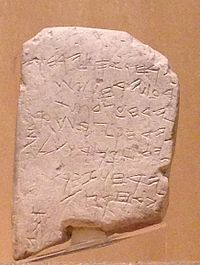Gezer calendar

The calendar in its current location
|
|
| Material | Limestone |
|---|---|
| Size | 11.1 x 7.2 cm |
| Writing | Phoenician or paleo-Hebrew |
| Created | c. 925 BCE |
| Discovered | 1908 |
| Present location | Istanbul Archaeology Museums |
| Identification | 2089 T |
The Gezer calendar is a small inscribed limestone tablet discovered in 1908 by Irish archaeologist R. A. Stewart Macalister in the ancient Canaanite city of Gezer, 20 miles west of Jerusalem. It is commonly dated to the 10th-century BCE, although the excavation was unstratified and its identification during the excavations was not in a "secure archaeological context", presenting uncertainty around the dating.
Scholars are divided as to whether the language is Phoenician or Hebrew and whether the script is Phoenician (or Proto-Canaanite) or paleo-Hebrew.
The calendar is inscribed on a limestone plaque and describes monthly or bi-monthly periods and attributes to each a duty such as harvest, planting, or tending specific crops.
The inscription is in Phoenician or paleo-Hebrew script, which in equivalent square Hebrew letters is as follows:
It has been translated as:
Scholars have speculated that the calendar could be a schoolboy's memory exercise, the text of a popular folk song or a children's song. Another possibility is something designed for the collection of taxes from farmers.
The scribe of the calendar is probably "Abijah", which means "Yah (a shortened form of the Tetragrammaton) is my father". This name appears in the Bible for several individuals, including a king of Judah (1 Kings 14:31).
The calendar was discovered in 1908 by R.A.S. Macalister of the Palestine Exploration Fund while excavating the ancient Canaanite city of Gezer, 20 miles west of Jerusalem.
...
Wikipedia
